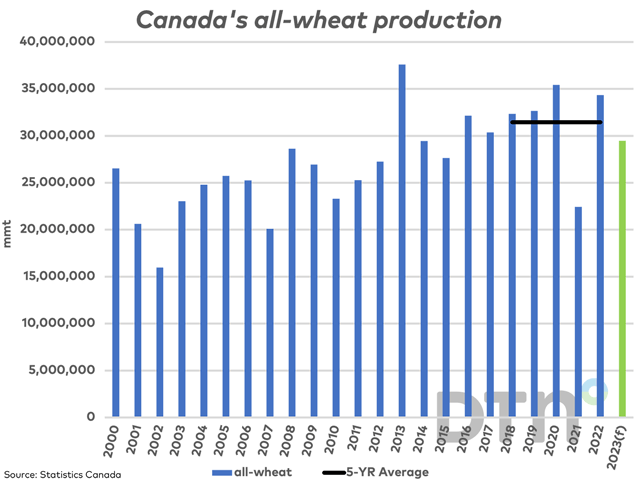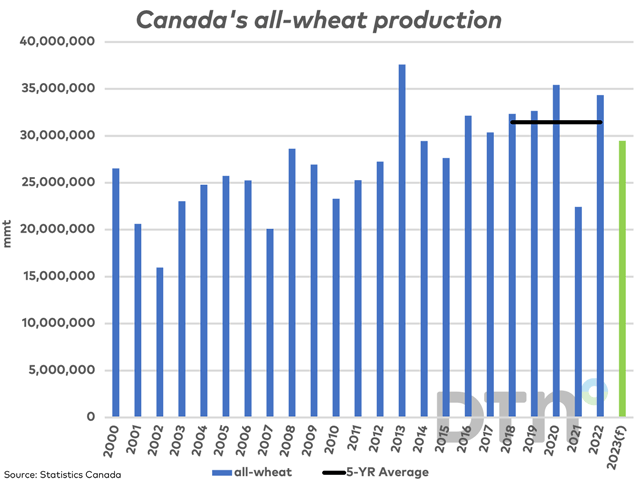Canada Markets
Statistics Canada Releases First of Two Crop Production Estimates
Statistics Canada's Model-based principle crop estimates were released today, based on July model data, while this report will be followed up with a second report on Sept. 14 based on August model data.
As expected, due this year's western drought, today's estimates differed from east to west, with more corn and soybeans forecast to be produced while western crop production is forecast to fall year-over-year due to drought centered in western Saskatchewan and Alberta.
Canada's all-wheat production is estimated at 29.472 million metric tons (mmt), just slightly above the lowest estimate seen in pre-report estimates and below the 30.4 mmt average of pre-report estimates. This volume is down 14.2% from 2022 and 6.3% below the five-year average, while the second-lowest volume produced in the past eight years.
Today's official spring wheat production was estimated at 22.1 mmt, 1 mmt below the average of pre-report estimates, down 14.6% from last year and 6.5% below the five-year average. This is despite the largest spring wheat area seeded since 2001, or 22 years. The national average yield is estimated at 42.6 bushels per acre (bpa), down 19.9% from 2022, while by province, Saskatchewan's yield is estimated to fall by 26%, Alberta's yield to fall by 18% and Manitoba by 8.6% from 2022. As well. Statistics Canada revised 2022 production higher by 204,868 metric tons (mt).
Durum production is estimated at 4.259 mmt, close to equal to the pre-report estimates, down 26.4% from last year and 18.7% or 1 mmt below the five-year average. If achieved, this would be the second-lowest production seen in 12 years, while falls far short of the 5.1-mmt export demand achieved in 2022-23. The national average yield is estimated at 26.8 bpa, down 25.3% from a year ago, with the Saskatchewan yield estimated at 26.5 bpa, down 23.4% and the Alberta yield at 28.1 bpa, down 31.3% from a year ago. Like spring wheat, Statistics Canada also revised higher their forecast for 2022-23 production by 346,524 mt.
P[L1] D[0x0] M[300x250] OOP[F] ADUNIT[] T[]
Statistics Canada estimated Canada's canola crop at 17.561 mmt, slightly higher than the average of pre-report estimates, down 6.1% from last year and 5.6% below the five-year average. The average Canadian yield is estimated at 35.4 bpa, down 8.8% from a year ago, with the average Manitoba yield down 9.5% from a year ago, the Saskatchewan yield down 13.9% while the Alberta yield is estimated 1.8% higher than a year ago. As expected, an upward revision to production was made for previous years, with 2022 production revised 520,994 mt higher and 2021 production revised 495,995 mt higher. This was made necessary due to the higher-than-expected commercial stocks held as of July 31 while old-crop canola continued to be delivered over the first few weeks of 2023-24 at a time when the canola harvest had yet to start.
Canola futures have reacted higher, with the November contract up $3.40/mt in late-morning trade after reaching a fresh high in its short-term uptrend of $821/mt. While the crush remains robust, there remains a lack of activity on the export side; positive signals on the export side will be needed to send this market to higher levels.
Canada's oat production was estimated at 2.429 mmt, below the average of pre-report estimates of 2.7 mmt. This would be the smallest volume produced since 1991, or 32 years, down 53.5% from last year and 40.4% below the five-year average. Oat seeded acres fell by 35.8% this spring and harvested acres are forecast to fall by 40.9%, with the high demand for feed due to prairie drought leading lost acres. Average yield is forecast to fall by 20.9 bpa, to 76.9 bpa, while compares to the five-year average of 87.3 bpa.
Barley production is estimated at 7.924 mmt, below the 8.4 mmt average of pre-report estimates, down 20.7% from 2022 and 14.7% below the five-year average. Despite a 3.9% increase in estimated acres seeded in 2023, and a 1% increase in estimated harvested acres, a 21.4% drop in estimated yield is seen offsetting the production from the increased acreage. This estimate is sharply below the unofficial AAFC estimate of 9.225 mmt, while explains the early aggressive buying of U.S. corn for import over the fall.
Lentil and dry pea production was estimated at levels well-below the average of pre-report estimates, due to a combination of lower-seeded acres and reduced yields. Lentil production is estimated at 1.537 mmt, which would be the lowest production in 14 years, down 33.2% from last year and 32.2% below the five-year average. The area seeded to lentils is estimated at 3.669 million acres, the lowest in nine years, down 15.1% from one year ago while 9.7% below the five-year average. At an average yield of 937 pounds/acre, average yield is estimated down 21.7% from one year ago and 25.4% below the five-year average. This is viewed as extremely bullish for lentil prices.
Dry pea production is estimated at 2.191 mmt, below the 2.6 mmt average of pre-report estimates, down 36% from one year ago and down 39.4% from the five-year average. At 3 million acres, acres seeded to peas would be the lowest in 12 years. At the same time, the average yield of 27.1 bpa is down 28% from last year and 22.3% below the five-year average. As with lentils, this report is viewed as bullish for the dry pea market.
Canada's soybean production is estimated at 6.735 mmt, equal to the average of pre-report estimates and would be the largest crop produced in five years. This volume would be up 2.9% from 2022, while 3% higher than the five-year average. Acres seeded to soybeans increased 356,500 acres, or 6.8%, across the country, with modest increases in Quebec and Saskatchewan along with a significant increase of 460,600 acres in Manitoba offsetting a 167,400 acre decline in Ontario. While yields are estimated to fall year-over-year in Saskatchewan and Manitoba, they are forecast to rise in Ontario and Quebec, with the national average yield expected to fall by 1.6 bpa nationally to 44.3 bpa, slightly above the five-year average of 44.1 bpa. Canadian soybean production is estimated at the third largest on record, with Quebec forecast to achieve record production of 1.270 mmt and Manitoba forecast to reach its highest production in five years. Ontario production is forecast slightly higher than the five-year average for the province.
Corn production is forecast at a record 14.727 mmt, close to the average of pre-report estimates although note that AAFC's unofficial estimate released in August estimated the crop at 15.3 mmt. This volume is 1.3% higher than estimated for 2022, while 5.2% higher than the five-year average of 14 mmt. Earlier this season, Statistics Canada estimated seeded acres at a record 3.825 mmt, with the largest gain of 175,300 acres for Manitoba easily off-setting a modest decline forecast for Ontario.
The national average corn yield is estimated at 156.1 bpa, down 4.3 bpa from 2022 while 1.1 bpa higher than the five-year average. A year-over-year drop in Quebec yield and a significant drop in forecast yield for Manitoba are seen off-setting a 3.7 bpa year-over-year increase seen in the estimate for Ontario.
Cliff Jamieson can be reached at cliff.jamieson@dtn.com
Follow him on X, formerly known as Twitter, @Cliff Jamieson
(c) Copyright 2023 DTN, LLC. All rights reserved.





Comments
To comment, please Log In or Join our Community .